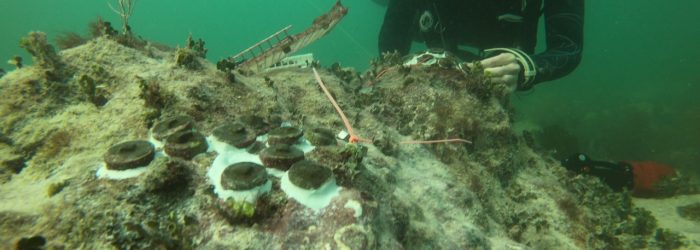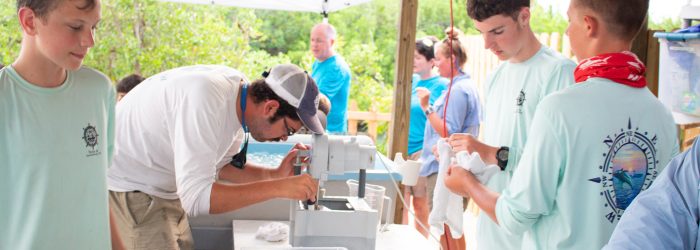CORAL RESTORATION
Why Restore the Coral Reef?
Worldwide, coral reefs provide habitat, oxygen, and complement other marine ecosystems to support the diverse marine life in our oceans. Barrier reefs can also serve to reduce wave buildup and protect shorelines during tropical storm or hurricane weather.
The health of the coral reef has been declining for decades, exacerbated in recent years by mass bleaching events, changes in water quality, sustained high water temperature, and disease among corals. The decline of the reef is happening faster than its ability to grow and heal naturally.
Work conducted by the Coral Restoration Foundation is completed under Florida Keys National Marine Sanctuary permits.
FKNMS-2019-012
What is a Citizen Scientist?
Science, research and restoration efforts can be much more impactful when members of the general public are involved. Greater strides are possible when citizens work with scientific organizations to expand research and efforts; by playing a part in collecting and analyzing data.
Sea Base’s scouts are included as citizen scientists in an amazing restoration effort in the Florida Keys. They are helping to revitalize the coral reef for generations of marine life and visitors to continue to enjoy.
All work conducted from the Brinton Environmental Center is done under Florida Keys National Marine Sanctuary and Florida Fish and Wildlife Conservation Commission permits respectively.
FKNMS-2021-101-A1
SAL-22-2486-SCRP
BRINTON ENVIRONMENTAL CENTER CORAL NURSERY
In 2019, Sea Base developed the first land-based coral nursery of its kind on-site at the Brinton Environmental Center (BEC).
The Coral Nursery at the BEC was constructed with the goal of supporting ongoing coral restoration efforts in the Florida Keys National Marine Sanctuary (FKNMS) and to serve as an educational facility where youth and students actively participate in the restoration process.
Through the implementation of the micro-fragmentation technique, the BEC is able to expedite the growth of slower growing bouldering/mounding coral species and ultimately outplant 8 different species of hard corals.


Our goals are not limited to restoration however. Scouts adventuring at the BEC have the option to receive hands-on tours to learn about Florida’s Coral Reef and restoration efforts and techniques throughout the FKNMS. Furthermore, scouts participating in the Marine STEM Adventure are even to help in the micro fragmentation process firsthand!
Learn more about the restoration techniques used at the BEC below:
Coral reefs, an essential hardbottom habitat found in Florida, are one of the most diverse ecosystems on planet earth and home to many ecologically important fish and invertebrate species (Carpenter et al., 2008, Idjadi & Edmunds, 2006). Reefs also support the fishing and tourism industry; the coral reefs of Southeast Florida are estimated to have an economic value of $8.5 billion, with $4.4 billion in local sales and $2 billion in local income, providing 70,400 jobs to residents (Johns et al., 2001). As commercial and residential development continues, it is essential for coral reefs to help assist in shoreline protection and prevent erosion of infrastructure (FWC, 2019). Since the 1980’s coral reefs have seen a significant decline in coral cover from biological and anthropogenic stressors, both local and global, ranging from nutrient run off, increase in water temperatures, and ocean acidification, these stressors will only become more prolific, as climate change continues (Muldrow, 2020; FWC 2019).
In response to decades of decline, coral restoration is being conducted along the Florida Reef Tract, primarily focusing on coral gardening techniques utilizing Acropora cervicornis (Young et al., 2012; Lirman et al., 2010). As reef restoration work continues, a need to focus on slower growing bouldering and mounding corals needs to be explored (Forsman et al., 2015). Due to their slow growth rates, these species have not been focused on for restoration (Page et al., 2018). The micro-fragmentation method, coupled with ex-situ nurseries allow rescue coral to be fragmented into square centimeter pieces, allowing little material to be collected from the wild (Page et al., 2018). Growing fragments in tanks allows for coral to remain in disease free and stable conditions year-round and gives practitioners daily access to care for corals (Forsman et al., 2015). Cutting corals to such a small size, in stable conditions, allows for corals to accelerate in growth, which is advantageous for survival (Forsman et al., 2015; Okubo et al., 2006). These fully grown fragments will be fragmented again to restock the nursery or outplanted onto degraded reefs (Page et al., 2018). This technique has been utilized in the Florida Keys since 2013, with the overall goal of not only increasing coral cover but making corals sexually mature faster, so they can reseed the degraded reefs themselves.
Utilizing these techniques the nursery houses ~15,000 corals, three which are listed as ESA threatened species and four which are susceptible to Stony Coral Tissue Loss Disease (SCTLD). Sea Base grows and produces Solenastrea bournoni (Smooth Star Coral), Porites astreoides (Mustard Hill Coral), Pseudodiploria strigosa (Symmetrical Star Coral), Acropora palmata (Elkhorn Coral), and Acropora cervicornis (Staghorn Coral). The nursery primarily focuses on producing Montastraea cavernosa (Great Star Coral), Pseudodiploria clivosa (Knobby Brain Coral), and Orbicella faveolate (Mountainous Star Coral). Florida Sea Base’s (FSB) land-based nursery is used primarily used as an educational tool for scouting and non-scouting groups, where young men and women can experience what it is like to be a restoration practitioner put also contributes to local restoration efforts. Once fragments are fully grown they are outplanted on degraded reefs. In 2022 Florida Sea Base outplanted 4,000 corals off the Lower Keys. Each year Florida Sea Base plans to outplant 4,000 corals on local degraded reefs with the help from scouts!
Utilizing a diamond blade tile saw, corals of opportunity are cut into small fragments. These corals are acquired from rescue or partnering nurseries. When cutting a coral of opportunity, all the sides of the coral are abraded to stimulate a growth response. Once the coral has been abraded, it is cut into small 1cm wide strips. Next these strips are cut into strips, it is cut into micro-fragments of 1cm sq. in size. After a micro-fragment has been produced it will be super glued onto a ceramic plug where it will grow the full size of the plug in our raceways for 6- 12 months. Once the fragment has grown the full size of the plug it can be fragmented again or outplanted to degraded reefs.
Corals are outplanted in locations that offer the best chance of survival, as well as, help restore natural distribution. Once locations for outplant sites are determined, algae is removed from the skeleton using a wire brush. Divers will drill / prepare the area creating an area or array to place fragments. After the array is prepared by drilling holes, the plugs are pushed into the holes and adhered to reef using a two-part marine epoxy. To monitor corals all arrays, have an associated aluminum tag recording the date outplanted, species, genotype, and number of plugs in an array. This will help the BSA identify resilient species and genotypes.
OUTPLANTING WITH CORAL RESTORATION FOUNDATION
In 2022, Sea Base began offering the SCUBA Advanced Marine Exploration Adventure.
In the new program, scouts have the opportunity to earn their PADI Advanced Open Water certification, and to work with the Coral Restoration Foundation (CRF) to help restore coral reefs.
Based out of the Florida Keys, CRF’s main goals are to restore the reefs of the Florida Keys and assist where we can globally, inspire and empower people to speak about the importance of our oceans and to use science to further our coral monitoring techniques. This massive large-scale action effort not only involves tens of thousands of corals, but tens of thousands of people too! Through our educational programs, students can learn about coral anatomy and the dangers corals reefs face today, as well as get in-water experience as certified SCUBA divers or snorkelers. By teaching students about coral reef conservation and giving them the opportunity to practice real world restoration techniques on land and in person, participants get the unique opportunity to care for coral trees, return a coral to the wild and learn how to be an ocean steward.
References:
– Carpenter KE, Abrar M, Aeby G, Aronson RB, Banks S, et al. .2008. One-third of reef building corals face elevated extinction risk from climate change and local impacts. Science 321: 560–563.
– Forsman ZH, Page CA, Toonen RJ, Vaughan D .2015. Growing coral larger and faster: micro-colony-fusion as a strategy for accelerating coral cover. PeerJ3:e1313; DOI10.7717/peerj.1313
-FWC. 2019. Florida’s State Wildlife Action Plan.
-Idjadi JA, Edmunds PJ .2006. Scleractinian corals as facilitators for other invertebrates on a Caribbean reef. Mar Ecol Prog Ser 319: 117–127.
-Johns G., Leeworthy V., Bell F., Bonn M. 2001. Socioeconomic study of reefs in Southeast Florida.
-Lirman D., Thyberg T., Herlan J., Hill C., Young-Lahiff C., Schopmeyer S., Huntington B., Santos R., Drury C. 2010. Propagation of the threatened Staghorn Acropora cervicornis: Methods to minimize the impacts of fragment collection and maximize production. coral reefs (2010) 29:729–735 DOI 10.1007/s00338-010-0621-6
-Muldrow M., Parsons E., Jonas R. 2020. Shifting baseline syndrome among coral reef scientists. Humanities and Social Sciences Communications volume 7, Article number: 42
-Muller EM, Sartor C, Alcaraz NI, Van Woesik R. 2020. Spatial epidemiology of the stony-coral-tissue-loss disease in Florida. Frontiers in Marine Science 7:163
-NOAA. 2020. Coral reef condition: A status report for Florida’s coral reefs.
-Okubo N., Motokawa T., Omori M. 2006. When fragmented coral spawn? Effect of size and timing an survivorship and fecundity of fragmentation in Acropora formosa. Mar Biol (2007) 151:353–363 DOI 10.1007/s00227-006-0490-2
-Page CA, Muller EM, Vaughan D. 2018. Microfragmentation for the successful restoration of slow growing massive corals. Ecological Engineering 123: 86-94
-Young CN., Schopmeyer SA., Lirman D. 2012. A review of reef restoration and coral propagation using the threatened genus Acropora in the Caribbean and Western Atlantic. Bulletin of Marine Science. 88 (4):1075-1098. 2012 http://dx.doi.org/10.5343/bms.2011.1143